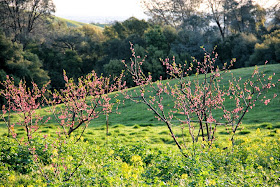After endless hot summer days with hazy cloudless skies we are reveling in the cooler air and beautiful clouds of fall. And while the rumored El Nino-fueled heavy rains have yet to arrive, we have at least received enough light rains to begin seeing a slight green tinge to the golden hills. I planted our annual legume mix cover crop a few weeks ago and it is sprouting nicely.
I've also begun the annual orchard pruning. It's a tedious job involving hundreds of cuts per tree. But it is not without its pleasures: being up on a ladder, enjoying the fresh air and sky, watching hawks and other birds go about their daily search for food, and admiring the sculptural look of a nicely pruned tree. With a birds-eye view of the upper branches it is also reassuring to see some of our valuable partners in pest control - predator insects, the good bugs that eat the bad ones. Below are shots I took just recently while pruning an apricot tree.
 |
| Green Lacewings are a common and welcome sight in the orchard. They, and especially their larvae, feed on a wide range of pest insects such as aphids. |
 |
| A praying mantis egg case stuck to an apricot shoot, waiting until spring to hatch. When I see one of these I either skip pruning that shoot or cut it off and tie it to another part of the tree. |
 |
| An adult praying mantis waits to ambush a passing insect |
Of course fall is also persimmon time and despite the drought our trees are bearing a good crop of fuyus. Right now we only have enough to supply our main restaurant customer, but by Thanksgiving the fuyus should be ripening in good numbers. When more are available we will email an announcement to our fruit customer list. In the meantime, below is an artsy shot I took using a creative "watercolor" effect I've been playing with on a new camera.
Thanks,
Bill
Bill
































